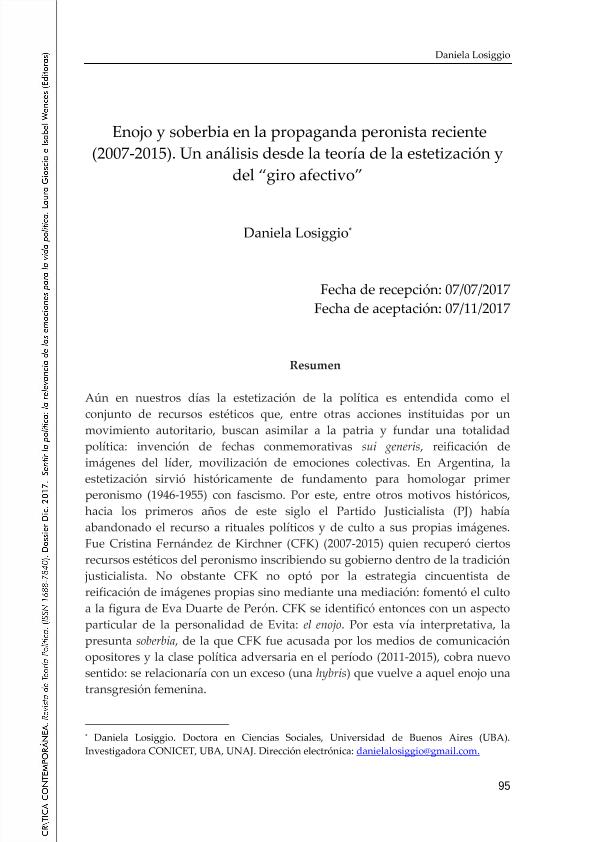Artículo
Aún en nuestros días la estetización de la política es entendida como el conjunto de recursos estéticos que, entre otras acciones instituidas por un movimiento autoritario, buscan asimilar a la patria y fundar una totalidad política: invención de fechas conmemorativas sui generis, reificación de imágenes del líder, movilización de emociones colectivas. En Argentina, la estetización sirvió históricamente de fundamento para homologar primer peronismo (1946-1955) con fascismo. Por este, entre otros motivos históricos, hacia los primeros años de este siglo el Partido Justicialista (PJ) había abandonado el recurso a rituales políticos y de culto a sus propias imágenes. Fue Cristina Fernández de Kirchner (CFK) (2007-2015) quien recuperó ciertos recursos estéticos del peronismo inscribiendo su gobierno dentro de la tradición justicialista. No obstante CFK no optó por la estrategia cincuentista de reificación de imágenes propias sino mediante una mediación: fomentó el culto a la figura de Eva Duarte de Perón. CFK se identificó entonces con un aspecto particular de la personalidad de Evita: el enojo. Por esta vía interpretativa, la presunta soberbia, de la que CFK fue acusada por los medios de comunicación opositores y la clase política adversaria en el período (2011-2015), cobra nuevo sentido: se relacionaría con un exceso (una hybris) que vuelve a aquel enojo una transgresión femenina. En los siguientes apartados nos abocaremos, primero, a determinar de qué se trata la existencia actual de las apariencias (políticas), despejando de esa conceptualización una perspectiva moralizante. En segundo lugar, buscaremos analizar de qué se trata la movilización de imágenes y afectos por parte de los primeros peronismos, procurando destacar el rol esencial que juega allí la figura de Evita. En este marco, en tercer lugar, buscaremos analizar la introducción de la figura de Evita en la primera presidencia de CFK. ¿En qué sentido es central para el gobierno de CFK el agenciamiento de los afectos enojo y soberbia? ¿En qué sentido ellos están en vinculación con los estereotipos contemporáneos de lo feminino y en qué sentido vienen a quebrarlos? Even today, the aestheticization of politics is understood as the set of aesthetic resources that, among other actions instituted by an authoritarian movement, seek to assimilate the homeland and found a political totality: invention of sui generis commemorative dates, reification of the leader’s images, mobilization of collective emotions. In Argentina, aestheticization historically served as the basis for equalizing first Peronism (1946-1955) with fascism. For this, among other historical reasons, towards the first years of this century, the Justicialista Party (PJ) had abandoned the resource to political rituals and the cult of its own images. It was Cristina Fernandez de Kirchner (CFK) (2007-2015) who recovered certain aesthetic resources from justicialismo; this way she engraved her government within the Peronist tradition. However, CFK did not opt for the fifties strategy of reification of its own images but through a mediation: she fomented the cult of Eva Duarte de Perón’s figure. CFK then identified with a particular aspect of Evita's personality: anger. Through this interpretation, the presumed arrogance, of which CFK was accused by the opposition media and the adversary political class in the period 2011-2015, takes on new meaning: it would be related to an excess (a hybris) that turns that anger into transgression. In the following sections we will first try to determine what the current existence of appearances (political) is about, removing a moralizing perspective from that conceptualization. Secondly, we will try to analyse what the Peronist mobilization of images and affections is, trying to emphasize the essential role played there by the figure of Evita. In this context, in the third place, we will try to analyse the introduction of the figure of Evita in the first presidency of CFK. In what sense are the affections of anger and arrogance central to the CFK government? In what sense are they in connection with the contemporary stereotypes of the feminine and in what sense do they come to break them?
Enojo y soberbia en la propaganda peronista reciente (2007-2015). Un análisis desde la teoría de la estetización y del “giro afectivo”
Fecha de publicación:
12/2017
Editorial:
Universidad de la República. Facultad de Ciencias Sociales. Instituto de Ciencia Política. Grupo de Estudios sobre Ciudadanía
Revista:
Critica Contemporanea
ISSN:
1688-7840
Idioma:
Español
Tipo de recurso:
Artículo publicado
Clasificación temática:
Resumen
Palabras clave:
Estetización
,
Peronismo
,
Enojo
,
Soberbia
Archivos asociados
Licencia
Identificadores
Colecciones
Articulos(SEDE CENTRAL)
Articulos de SEDE CENTRAL
Articulos de SEDE CENTRAL
Citación
Losiggio, Daniela; Enojo y soberbia en la propaganda peronista reciente (2007-2015). Un análisis desde la teoría de la estetización y del “giro afectivo”; Universidad de la República. Facultad de Ciencias Sociales. Instituto de Ciencia Política. Grupo de Estudios sobre Ciudadanía; Critica Contemporanea; 7; 12-2017; 95-128
Compartir




